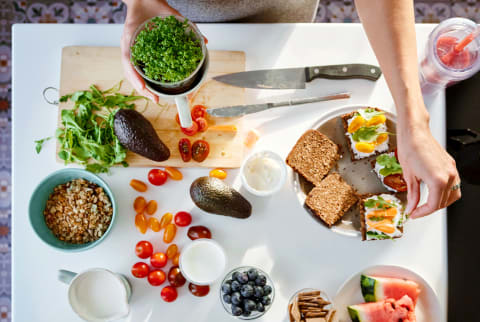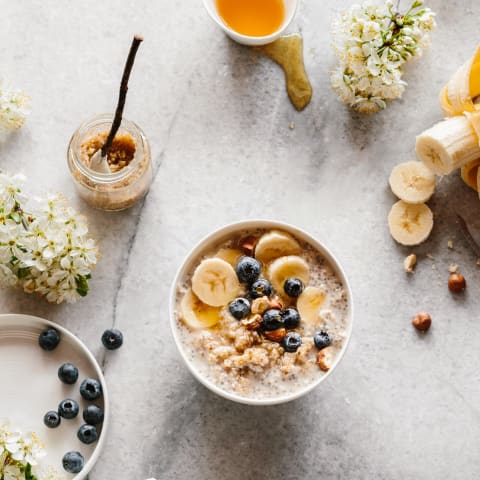Advertisement
I Thought I Knew Everything About Nutrition, Then I Took mbg's Functional Nutrition Program


As the health editor here at mindbodygreen, I like to consider myself an expert in all things nutrition and wellness. I've worked in the field of integrative and functional medicine for years and even have a master's degree in physiology and complementary and alternative medicine (humble brag). But when I took mindbodygreen's Functional Nutrition Program, I realized that there's a lot I don't know. The truth is, there's always more to learn about health—from healing chronic inflammation and hormone imbalances through dietary changes, to what we can all be doing to promote longevity and prevent chronic disease.
Here are four important things I took away from the program:
1. Infections are a major overlooked cause of autoimmune disease.
I think it's safe to say we're all afraid of ticks and the many infections they can cause. But what I'd forgotten is that infections like Lyme disease, babesia, and bartonella can drive inflammation in a serious way, leading to autoimmune disease. And with the way tick populations are growing and Lyme disease is spreading1, it's something we should all be more aware of.
So how do you know if you have one of these tick infections? If you get a tick bite, you can send it in to be tested by a lab, but if you're experiencing symptoms or suffering from an autoimmune disease, try taking this MSIDS questionnaire developed by Dr. Richard Horowitz.
One last tidbit: It's not just ticks! Other hidden infections like EBV and tooth infections can be a major trigger of autoimmune disease, so it's always a good idea to see a functional medicine doctor if you're suffering from symptoms, even though your diet and lifestyle are on the right track.
2. Blanching is the cool way to cook greens.
There are certain greens that I find more difficult to eat than others; on that list are bok choy, broccolini, and Swiss or rainbow chard. They just don't fit easily in most salads, I don't like to bake them, and boiling a green takes forever and sucks out some of the nutrient content (although interestingly, it actually increases the bioavailability of nutrients in some veggies, like tomatoes and carrots). I had never really heard of blanching until Kelly LeVeque, mbg Collective member and author or the best-selling book Body Love—who also happens to be the host of the mbg Functional Nutrition Program—gave a tutorial on blanching in the section on traditional cooking techniques.
But how do you blanch a leafy green? Start by pouring a few inches of water into the bottom of a large sauté pan on medium to high heat. Once it starts to boil, add the broccolini (or other leafy green) and cook for 2 to 5 minutes or until the leaves start turning a darker green color. Then flip the green to cook on the other side. Once it's fork tender, you can drain the water and then sauté it for a few minutes in a fat of your choice (I like ghee or avocado oil). Blanching is a lot like boiling, but it's quick, and you're not losing all the vitamins you would if you boiled your veggies. Win-win!
3. Soaking seeds, nuts, and grains is worth the hassle.

Soaking and sprouting nuts, seeds, grains, and legumes has always felt like a lot of work to me. I did it occasionally but never really made a solid commitment to doing it. But after taking mbg's Functional Nutrition Program, I'm finally convinced. Not only does it make it easier to digest them, it gets rid of the phytic acid and other enzymes that can interfere with nutrient absorption and irritate the gut. And so, slightly begrudgingly, I'll start buying sprouted products where I can afford them and always soak and rinse my overnight oats.
4. Sugar is (still) a huge problem.
When you're living in the Brooklyn wellness bubble, it's easy to forget that, in other parts of the country, juice bars don't exist on every corner and many people don't have access to the same kind of healthy food and nutrition knowledge that I do. Despite the fact that I know Americans eat way too much sugar, I was still floored to learn that the average person consumes 80 grams of sugar daily, which is 66 pounds of sugar a year. All Americans need to know that sugar is hiding everywhere—in our breads, milks, yogurt, granola, condiments, and coffees (just to name a few).
Personally, I try my very best to keep my added sugar consumption to under 10 grams per day. I like to get my daily dose of sweetness through whole fruits and dark chocolate, with only 2 or 3 grams of sugar added per serving. Dr. Mark Hyman, a leader in integrative and functional medicine and instructor in this portion of the training, immediately connects this excess sugar consumption with the mental health crisis we're currently facing. It's a good reminder that we are what we eat—and that's especially true for the brain.
It pays to get your nutrition knowledge straight from the source—from experts in the world of functional nutrition like Dr. Joel Kahn, Dr. Taz Bhatia, and Dr. Frank Lipman. The instructors of this program were handpicked and have written best-selling books, started their own practices, founded healthy restaurants, and have been working tirelessly to spread foods as medicine into the world for years on end.
Try mbg's Functional Nutrition Program for yourself, here.
Watch Next
Enjoy some of our favorite clips from classes
Enjoy some of our favorite clips from classes
What Is Meditation?
Mindfulness/Spirituality | Light Watkins
Box Breathing
Mindfulness/Spirituality | Gwen Dittmar
What Breathwork Can Address
Mindfulness/Spirituality | Gwen Dittmar
The 8 Limbs of Yoga - What is Asana?
Yoga | Caley Alyssa
Two Standing Postures to Open Up Tight Hips
Yoga | Caley Alyssa
How Plants Can Optimize Athletic Performance
Nutrition | Rich Roll
What to Eat Before a Workout
Nutrition | Rich Roll
How Ayurveda Helps Us Navigate Modern Life
Nutrition | Sahara Rose
Messages About Love & Relationships
Love & Relationships | Esther Perel
Love Languages
Love & Relationships | Esther Perel
What Is Meditation?
Box Breathing
What Breathwork Can Address
The 8 Limbs of Yoga - What is Asana?
Two Standing Postures to Open Up Tight Hips
How Plants Can Optimize Athletic Performance
What to Eat Before a Workout
How Ayurveda Helps Us Navigate Modern Life
Messages About Love & Relationships
Love Languages
Advertisement

What Men Are Getting Wrong About Mental Health, From A Psychologist
Stephen B. Poulter, PhD

Your Grandma's Go-To Supplement Is Once Again Popular (For A Good Reason)
Molly Knudsen, M.S., RDN

What Men Are Getting Wrong About Mental Health, From A Psychologist
Stephen B. Poulter, PhD

Your Grandma's Go-To Supplement Is Once Again Popular (For A Good Reason)
Molly Knudsen, M.S., RDN













